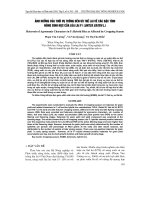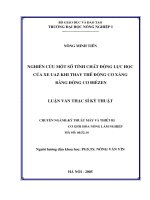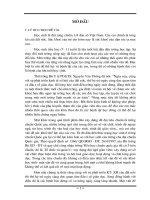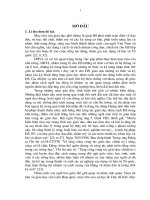BUILDING STRUCTURE PARAMETER IDENTIFICATION USING THE FREQUENCY DOMAIN DECOMPOSITION (FDD) METHOD NHẬN DẠNG các THÔNG số ĐỘNG lực học của tòa NHÀ BẰNG PHƯƠNG PHÁP FDD
Bạn đang xem bản rút gọn của tài liệu. Xem và tải ngay bản đầy đủ của tài liệu tại đây (592 KB, 10 trang )
Kỷ yếu hội nghị khoa học và công nghệ toàn quốc về cơ khí - Lần thứ IV
BUILDING STRUCTURE PARAMETER IDENTIFICATION USING THE
FREQUENCY DOMAIN DECOMPOSITION (FDD) METHOD
NHẬN DẠNG CÁC THÔNG SỐ ĐỘNG LỰC HỌC CỦA TÒA NHÀ BẰNG PHƯƠNG
PHÁP FDD
Loc Nguyen Phuoc1a, Phuoc Nguyen Van2b
1
Kien Giang Vocational College, Vietnam
2
HCMC University of Technical and Education, Viet Nam
a
;
ABSTRACT
In recent years, Operational Modal Analysis, also known as Output-Only Analysis, has
been used for estimation of modal parameters of the structures such as the buildings, bridges,
towers, and mechanical structures. The advantage of this method is that expensive excitation
equipment can then be replaced by ambient vibration sources such as wind, wave, and traffic
used as input of unknown magnitude, and then modeled as blank interference in the modal
identification algorithms. This paper presents an overview of the non-parameter technique
based Frequency Domain Decomposition (FDD), dynamic model of n-storeybuilding and
method of modal parameters identification using FDD. In addition, using statistical probability
to evaluate the results that obtained the stiffness and inter-storey dift of 2-storeybuilding.
Keywords: FDD: Frequency Domain Decomposition, OMA: Operational Modal
Analysis, MDOF: Multi-Degree of Freedom, SDOF: Single-Degree of Freedom, EMA:
Experimental Modal Analysis, SVD: Singular Value Decomposition.
TÓM TẮT
Những năm gần đây, phân tích thể thức (Modal) hoạt động được biết đến với tên gọi là
Phân tích chỉ với ngõ ra, đã được sử dụng để ước lượng các tham số của các công trình như
các tòa nhà, cầu, tòa tháp và các cấu trúc cơ khí. Thuận lợi của phương pháp này là những
thiết bị kích thích đắt tiền có thể được thay thế bằng các nguồn rung động từ môi trường xung
quanh, chẳng hạn như các rung động từ gió, sóng và lưu thông xe cộ được sử dụng như là ngõ
vào với biên độ khôngđượcquan tâm, chúng được mô hình hóa như nhiễu trắng trong các giải
thuật nhận dạng thể thức (modal). Bài báo này trình bày tổng quan về kỹ thuật không tham số
dựa trên việc phân giải trong miền tần số, mô hình động học của tòa nhà n tầng và phương
pháp nhận đạng các tham số modal sử dụng FDD.Thêm vào đó, sử dụng xác suất thống kê để
đánh giá các kết quả đạt được về độ cứng (stiffness) và độ xê dịch tầng (inter-storey dift) của
tòa nhà 2 tầng.
Từ khóa: FDD: Phân giải trong miền tần số, OMA: Phân tích thể thức hoạt động,
MDOF: Đa bậc tự do, SDOF: Một bậc tự do, EMA: Phân tích thể thức thực nghiệm, SVD:
Phân giải giá trị đơn.
1. INTRODUCTION
The experimental determination of structural modes of a structure can be divided into
two methods: EMA and OMA. Experimental Modal Analysis requires knowledge of both
input and output, which can be combined to yield stransfer function that describes the system.
In recent decades, there are civil structures used OMA method. This method has been
developed for many civil engineering structures such as buildings, bridges, rigs,…[1].
Operational modal analysis only requires measurement of the output from the system. In FDD
method, spectral density matrix of multi-degree of freedom system is decomposed into a set
772
Kỷ yếu hội nghị khoa học và công nghệ toàn quốc về cơ khí - Lần thứ IV
of auto spectral density functions, each corresponding to a single degree of freedom. This
method is illustrated by the measurement on a two-storey building model with the excitation
source generated by a small hard plastic hammer and a vibration motor.The advantage of
using data acquisition hardware NI-USB 9234 of National Instruments is to easily measure
responses of accelerometers installed along the height of the building with LabVIEW 2011 as
showed in Figure 1. Then the data continues to be analyzed with Matlab with the support of
advanced signal processing tools. Finally, the modal parameters of the building are obtained
as resonant frequency and mode shapes. In addition, the stiffness of each floor is also
identified under the shear beam model assume of a two-storey building.
Figure 1. Data acquisition system with NI-USB 9234 hardware in LabVIEW 2011
2. MAIN CONTENT
2.1. Frequency Domain Decomposition (FDD)
The power spectrum density matrices of the input (unknown) and output (recorded)
signal as functions of angular frequency ω respectively noted [X ](ω ) and [Y ](ω ) . They are
associated to the frequency response function matrix [H ](ω ) through the following equation
[2,3,5,6,8,9]:
[Y ](ω ) = [H ](ω )∗ [X ](ω )[H ](ω )T
(1)
T
Where: ∗ is denoted complex conjugate and is transposed. If r is the number of inputs
and m is the number of simultaneous recorded signals, at each angular frequency ω , the size
of [X ](ω ) , [Y ](ω ) and [H ](ω ) are r × r , m × m and m × r , respectively. In Operational Modal
Analysis, the usual assumption is that the input is white noise. That means the power spectral
density matrix is expressed:
[X ](ω ) = [C ]
(2)
Where [C ] is constant matrix. The [H ](ω ) matrix can be written in a pole ( λk ) and
Residue ( [Rk ] ) formas:
n
[H ](ω ) = [Y ](ω ) = ∑ [Rk ]
[X ](ω ) k =1 jω − λk
Where:
+
[Rk ]∗
jω − λ∗k
λk = −σ k + ωdk
(3)
(4)
n is the total number of interested modes, λk is the pole of k th mode and σ k is the modal
damping of the k th mode, ωdk is the damped natural frequency of the k th mode:
ωdk = ω0 k 1 − ς k2
773
(5)
Kỷ yếu hội nghị khoa học và công nghệ toàn quốc về cơ khí - Lần thứ IV
Where: ς k is the critical damping of the k th mode, ω0 k is the undamped natural frequency
of the k th mode. [Rk ] matrix is called the residue matrix andis expressed as following form:
[Rk ] = φk γ kT
(6)
Where φk is the mode shape, λk is the modal participation vector. All those parameters
are specified for the k th mode. The input assumed to be blank interference with power spectral
density is flat (no change) over the entire frequency range, thus spectral power density matrix
[X ](ω ) is a constant matrix, so it can be writtenas [X ](ω ) = C , then Equation (1) becomes:
n
n
[Y ](ω ) = ∑∑ [Rk ]
k =1 l =1
jω − λ
+
[Rk ]∗
[Rl ]
[Rl ]∗
C
+
∗
jω − λk jω − λl jω − λ∗l
H
(7)
H
Where
is denotes complex conjugate and transposition. Multipying the two partial
fraction factors and making use of the heaviside partial fraction theorem, then performing
mathematical transformations, output power spectral densitycan be presented as follows
n
[Y ](ω ) = ∑ [Ak ]
k =1
jω − λ k
+
[Ak ]∗
jω − λ∗k
+
[Bk ]
− jω − λ k
+
[B k ]∗
(8)
− jω − λ∗k
Where: [Ak ] is the k th residue matrix. The matrix [X ](ω ) is assumed to be a constant C ,
since the excitation signals are assumed to be uncorrelated zero mean blank interference in all
the measured DOFs.This matrix is Hermitian; its size is m × m and is described in the form:
T
n [Rs ]H
[
Rs ]
[Ak ] = [Rk ]C ∑
+
∗
−
−
−
−
λ
λ
λ
λ
s
=
1
k
s
k
s
(9)
The contribution to the residue from the k th mode is given:
T
[
Rk ]C [Rk∗ ]
[A ] =
k
(10)
2σ k
Where: σ k is minus the real part of the pole λk = −σ k + jω dk . As it appears, this term
becomes dominating when the damping is light, and thus, is case of light damping; the residue
becomes proportional to the mode shape vector:
lim
damping →light
[Ak ] = [Rk ]C[Rk ]T
= φk γ kT Cγ kφkT = d kφkφkT
(11)
Where: d k is a scalar constant. The contribution of the modes at a particular frequency is
limited to a finte number. Let this set of modes be denoted by Sub(ω ) . Thus, in the case of a
lightly damped structure, the response of spectral density matrix can always be written as
following final form:
[Y ](ω ) = ∑
k∈Sub (ω )
d kφkφkT
d ∗φ ∗φ T
+ k k k∗
jω − λ k jω − λ k
(12)
The final form of the matrix [Y ](ω ) is decomposed into a set of singular values and
singular vectors using the Singular Value Decomposition.
2.2. Singular Value Decomposition
The singular value decomposition of an m × n complex matrix A is the following
factorization:
A = U × S ×V H
(13)
774
Kỷ yếu hội nghị khoa học và công nghệ toàn quốc về cơ khí - Lần thứ IV
Where U and V are unitary matrix and S is a diagonal matrix that contains the real
singular values:
S = diag ( s1 ,......., sr )
(14)
H
The superscript on the V matrix denotes a Hermitian transformation. In the case of real
T
valued matrices, the matrix V is only transposed and is denoted . The si elements in the
matrix S are called the singular values and their following singular vectors are contained in
the matrix U andV . This singular value decomposition is performed for each of the matrices
at each frequency. The experimental flowchart is built by using FDD method and is illustrated
through four stages as shown in Figure 2:
3 Acceleration Signals Recording
- Installation position of
sensors: ground, floor 1,
floor 2
20
15
10
5
0.5
1
0.5
0
-5
10
0
-5
0
10
Frequency[Hz]
cpsd21
0
-0.5
-1
-5
10
5
10
0.5
Amplitude
Time[s]
0
- Calculate the matrix of
power density spectral:
5
10
Frequency[Hz]
psd22
10
0.8
15
10
5
0
Amplitude
-10
- Fourier transform of the
measured responses:
determining the frequency
components: ωi
cpsd12
1.5
Amplitude
25
Acceleration [m/s 2]
psd11
- Simultaneous recordings.
Ground floor
1st Floor
2nd Floor
30
Amplitude
35
0
-0.5
-1
-5
10
0
10
Frequency[Hz]
PSD kk (ωi ) ;
0.6
0.4
0.2
0
-5
10
5
10
0
(this experiment we need to
use 2 sensors at 1st and 2nd
floor)
5
10
Frequency[Hz]
k = 1: n
10
- Calculate the cross spectral
density matrix:
1st singular vector at frequency 4.625
Amplitude
Floor 1
CSD pq (ωi ); p ≠ q
psd11
1.5
Floor 2
1
0.5
- From respone matrix :
0
-5
10
- Modal parameters:
0
10
Frequency[Hz]
cpsd21
5
10
PSD11 (ωi ) PSD12 (ωi )
PSD21 (ωi ) PSD22 (ωi )
[Y ](ωi ) =
0.5
-1
0
Amplitude
1
Amplitude
Ground
ωi , φi
0
-0.5
-1
-5
10
0
10
Frequency[Hz]
5
10
- Singular valued decomposition
[Y ](ω i ) = [U i ][S i ][U i∗ ]T
Figure 2. Experimental flowchart using FDD
The spectral density matrix is then approximated to the following expression (15) after
SVD decomposition:
With
[Y ](ω ) = [Φ ][S ][Φ ]H
(15)
[Φ ][Φ ]H = [I ]
(16)
Notation [I ] is unitary matrix.
Where S is a diagonal matrix holding the scalar singular values, [Φ ] is a unitary matrix
holding the singular vectors:
s1
0
0
S = diag ( s1 ,......., sr ) =
⋅
⋅
0
[Φ ] = [{φ1} {φ2 } {φ3 }
775
0
s2
⋅
⋅
⋅
⋅
⋅⋅⋅
0
0
s3
⋅
⋅
⋅
⋅ ⋅
⋅ ⋅
⋅ ⋅
⋅ ⋅
⋅ sr
0 0
{φr }]
0
⋅
⋅
0
0
0
(17)
(18)
Kỷ yếu hội nghị khoa học và công nghệ toàn quốc về cơ khí - Lần thứ IV
Where φi are forms of private modes. The number of nonzero elements in the diagonal of
the singular matrix corresponds to the rank of each spectral density matrix. The singular vectors
in Equation (18) correspond to an estimation of the mode shapes and the corresponding singular
values are the spectral densities of the SDOF system expressed in Equation (12).
2.3. Mathematical model of n-storey building
The building will vibrate when it is subjected to external forces exerted by the outside
like the wind, stimulated by vehicular traffic, caused by man, even earthquakes. To simplify
matters, we assume construction of the mathematical model for n-storey building under the
effect of making buildings earthquake vibrations. That means n degrees of freedom system
modeled from buildings also fluctuate.The vibration of n degrees of freedom of the form is
considered as figure H.2 [2,5]. Supposed thatthe moving is in one direction, according to
Newton's second law and D'Alembert principle, the equations of the system oscillate many
degrees of freedom under the effect of horizontal x ground acceleration x0'' (t ) is described as
follows [2,5]:
[M ]{x '' }+ [C ]{x ' }+ [K ]{x} = −[M ]{x0'' }
Where:
(19)
{x}T = [x1
x2
x3 ... xn ] ; {x '' } = [x1''
x2''
x3'' ... xn''
{x } = [x
x2'
x3' ... x ' ; x0''
] { } = [x
x0''
x0''
' T
'
1
T
T
''
0
...
]
x ]
''
0
x0'' = x0'' (t ) is ground acceleration (like as a system with a degree of freedom).
xi' (t ) , xi'' (t ) are displacement, velocity, acceleration in the mass
Respectively xi (t ) ,
dxi
d 2x
, xi'' (t ) = 2 i , [M ] is the mass matrix, [C ] is the
dt
dt
damping matrix, [K ] is the stiffness. We simulatenously diagonalize matrices [M ] and [K ] ;
and assume that [C ] is also diagonal with the n damping ratios ξ i on the diagonal. The n
concentration at the i th floor, xi' (t ) =
eigenvalues ωi2 , corresponding eigenvectors {φi } and damping ratios ξ i are the modal
parameters of the system.
All three matrices [M ] , [C ] , [K ] , each with size ( n × n ) and is defined as follows :
m1
0
[M ] =
0
0
0
m2
0
0
0
c11
c
0 ;
[C ] = 21
...
... 0
0 mn
c n1
0
0
c12
c 22
...
cn 2
... c1n
k11
k
... c 2 n ;
[K ] = 21
...
... ...
... c nn
k n1
k12
k 22
...
k n2
... k1n
... k 2 n .
... ...
... k nn
Where mi is the mass concentration at the i th floor, i = 1,2,...n
••
••
x0
xn
mn
••
••
x 0 + xi
mi
m1
••
x0
Figure 3. Mathematical model of n-storey building under the effect of horizontal ground
776
Kỷ yếu hội nghị khoa học và công nghệ toàn quốc về cơ khí - Lần thứ IV
2.4. Construct stiffness matrix from modal parameters
Shear beam model is assumed that motion in a single floor depends on the displacement
of the immediately above and below floors. The assumption is emphasized that the stiffness
of the floors is greater than the wall. Stiffness matrix can be written as formula (20):
k1 + k 2
−k
2
0
[K ] =
0
− k2
k 2 + k3
0
− k3
− k3
− k n −1
0
k n −1 + k n
− kn
0
0
− kn
k n
(20)
Where: k j is the stiffness of the storey j
The equation of the eigenvalues [K ]{Φ i } = ωi2 [M ]{Φ i }for the shear beam model can be
inverted in order to evaluate the stiffness matrix [K ] . Where: Respectively ω i , {Φ i } are modal
frequencies and mode shape vectors corresponding i th . Thus, the relationship between the
physical parameters and the modal parameters of the building can be expressed as the
equation (21):
([K ] − ω [M ]){Φ } = 0
2
i
(21)
i
Equation (21) can be written as elementary as the equation (22):
k k 2 m
0
0
k2
2
1
i 1
1i 0
k2 k3 i2 m2 k3
k2
2i 0
0
k3
K
0
(n1)i 0
2 mn1
k
k
k
k
1
1
n
n
n
n
ni 0
i
2
0
0
k
k
m
n
n
i n
(22)
Solving the equation (22) we find the stiffness from 1th floor to n th floor. Therefore, to
generalize a corresponding linear system equation (22) can be translated into analytical
formulas as follows:
Let:
( j 1)i when j 2 n
ji ji
ji
when
j 1
(23)
n
∀j ∈ [1, n], k j = ω
∑mφ
2
i
l li
l= j
φ ji − φ( j −1)i
(24)
Therefore, the expression (24) can be abbreviated as follows:
n
∀j ∈ [1, n], k j = ωi2
∑mφ
l= j
l li
∆φ ji
(25)
2.5. Identificate modal parameters and stiffness of model of 2-storey building
Geometry of a two-storey building is designed in the pattern of shear beam, painted
with software Artemis TestorPro 2011 as in Figure 4. The material is made entirely of carbon
steel.
777
Kỷ yếu hội nghị khoa học và công nghệ toàn quốc về cơ khí - Lần thứ IV
Figure 4. Geometry two-storey building
Acquisition of experimental system is for responses of model two-storey building.
Thesampling rate f s = 2048 samples/s, ensuring the Nyquist criterion. Step time retrieving
data is 4.8828125*10-4 (s). In this experiment, the data was recorded during 15 seconds.
Therefore the amount sampleson each channel were 30720 samples.
Experiment 1:
When the 1st and 2nd floor have m1 = m2 = mass = 11.9737 kg, excitation force
generated by a small hard rubber hammer on the 2nd floor in the horizontal x with a random
force. Results of from the 4th measurement in a data set withmeasured 10 times, is shown
infigures as follows:
Single-Sided Amplitude Spectrum of y Ground(t),y Floor1(t),y Floor2(t)
0.5
Amplitude Spectrum of y0
Amplitude Spectrum of y1
Amplitude Spectrum of y2
0.4
0.3
|Y(f)|
0.2
0.1
0
-0.1
-0.2
5
0
10
15
30
25
20
Frequency[Hz]
35
40
45
50
Figure5. One side of the spectrum amplitude response ground acceleration,
1st floor and 2nd floor
Through analysis of the spectrum we find out the ground nearly fluctuated. Thus to
simplify the problem, we only consider the correlation between 1st floor and 2nd floor. The
power spectral density of the system is calculated as a function of physical frequency is
shown in figure 5.
csd21
psd22
csd12
psd11
0
-1
Amplitude
1
Amplitude
Amplitude
1
0
10
20
30
Frequency[Hz]
d21
40
0
-1
-1
0
1
Amplitude
1
0
10
20
30
Frequency[Hz]
d22
40
0
-1
0
10
20
30
Frequency[Hz]
40
0
10
20
30
Frequency[Hz]
40
Figure 6. Power spectral densities of acceleration response and comment
on the 1st floor 2nd floor
In the first mode shape: the 1st and 2nd flooroscillate in phase, its displacement
increases with height, floor 2 shifted almost 1.5 times the 1st floor, frequency 10.6060 rad /s.
In the second mode shape: 1st and 2nd floor is opposite phase oscillation; a node appears. The
1st inter-story drift 2nd floor is near 1.5 times, frequency 29.0597 rad /s.
778
Kỷ yếu hội nghị khoa học và công nghệ toàn quốc về cơ khí - Lần thứ IV
z
z
y
y
x
x
Floor 2
Floor 2
Floor 1
Floor 1
Ground
Ground
1,688 Hz
4,625 Hz
Figure 7. Bending mode shapes along the identified high building
The modal parameters are identified and shown in Table 1:
Table 1. Mode shapes, stiffness identified when we used hard rubber hammer impact
with random excitation 2nd floor horizontal x
1st
Mode i
f (Hz)
2 nd
1,688
4,625
{ φi1 }
-0,55406
-0,83570
{ φi 2 }
-0,83247
0,54917
The average stiffness of the floor 1, floor 2 [N/m] and the
average frequency of two mode shapes of 10 independent
measurements
k1
Standard deviation ( d )
= 3317,091
k1
= 3414,902
k 2 = 1326,64
k 2 = 3949,381
f 1 = 1,688
f 2 = 4,625
d k1 = 1,758
d k1 = 7,374
d k2 = 0,0
d k2 = 2,669
d f1 =0,0
d f 2 =0,0
Sketch graphs stiffness andinter storey drift [m/m] between the floors is shown in
Figure 8 and Figure 9.
Longitudinal from 1st mode
Longitudinal from 1st mode
Longitudinal from 2nd mode
Longitudinal from 2nd mode
Floor 2
Floor 2
Floor 1
Floor 1
Ground
Ground
0
1
2
3
4
5
6
Kg/s2 or N/m
7
8
9
0
10
X 103
1
2
3
4
5
6
7
8
9
10
Inter-storey drift [m/m]
Figure 8. The stiffness of the floors
X 10-1
Figure 9. Inter-storey dirft
Experiment 2:
When the 1st and 2nd floor have m1 = m2 = mass = 11.9737 kg, the building suffered a
vibration stimuli from a DC motor is fastened on the ground of the 2- storey building model.
Figure 10and figure 11 show result of Single-sided amplitude spectrum and power spectral
density.
779
Kỷ yếu hội nghị khoa học và công nghệ toàn quốc về cơ khí - Lần thứ IV
Single-Sided Amplitude Spectrum of y Ground(t),y Floor1(t),y Floor2(t)
0.2
Amplitude Spectrum of y0
Amplitude Spectrum of y1
Amplitude Spectrum of y2
0.18
0.16
0.14
|Y(f)|
0.12
1,688 Hz
0.1
4,625 Hz
0.08
0.06
0.04
0.02
0
0
10
20
30
40
Frequency[Hz]
50
60
70
Figure 10. Single-sided amplitude spectrum of the ground acceleration responses, floor 1
and floor 2 to the stimulus was vibratingmotor
-3
x 10
4
2
0
-2
-4
0
-3
4
x 10
10
20
30
Frequency[Hz]
csd21
0
0
0
4
-2
10
20
30
Frequency[Hz]
40
csd12
-2
0
-3
2
-4
x 10
2
-4
40
Amplitude
Amplitude
-3
psd11
Amplitude
Amplitude
4
x 10
10
20
30
Frequency[Hz]
psd22
40
2
0
-2
-4
0
20
30
10
Frequency[Hz]
40
Figure 11. Power spectral densities of acceleration responses of the 1st floor, 2nd floor
Two mode shapes arealso identified when stimulated by a vibration motor and they are
nearly the same to Figure 7. The Table 2 shows the parameters of the two mode shapes and
stiffness per the floor in each mode are identified in the case used to create vibration motor:
Table 2. Mode shape, stiffness identified when using the vibration motor excitation on
the ground floor
1st
Mode i
f (Hz)
2 nd
1,688
4,625
{ φi1 }
-0,55406
-0,83570
{ φi 2 }
-0,83247
0,54917
k 1 =3303,395
k 1 =3620,982
k 2 =1326,644
k2
f 1 =1,688
f 2 =4,625
d k1 = 21,3642
d k1 = 304,2966
d k2 = 0,0
d k2 = 15,0906
d f1 = 0,0
d f 2 =0,0
The average stiffness of the floor 1, floor 2 [N/m] and the
average frequency of two mode shapes of 10 independent
measurements
Standard deviation ( d )
780
= 3917,751
Kỷ yếu hội nghị khoa học và công nghệ toàn quốc về cơ khí - Lần thứ IV
3. CONCLUSION
Recognized results between the two cases with a hard rubber hammer excitation and
vibration motor and shock with small deviations are acceptable. Oscillation frequency
separately unbiased for both mode shapes. Meanwhile, the stiffness of the 1st floor of mode 1
has deviation with 13.69562 N/m, the 2nd floor stiffness of mode 1 has deviationwith 0 N/m;
the 1st floor stiffness of mode 2 has deviation with 206,07993 N/m, the 2nd floor stiffness of
mode 2 has deviationwith 31.62963 N/m.
The analysis of modal with FDD allows us to easily identify the modal parameters
quickly and accurately. This was done only with the measurement of the response of the
building when it is subjected to the forces excited by the input amplitude regardless even
without measuring those excitation forces.This approach provides us with the bending
samples. However, it does not affect the calculation results about the stiffness according to the
mode shapes. FDD method which was successfully applied on a model two-storey building
was designed and constructed according to the pattern shear beam with identified modal
parameters and the stiffness of the floors. The stiffness is one of the main parameters
controlling their seismic resistance.The studied results have demonstrated the ability to use
the FDD into reality methods for civil engineering structures.It also can be applied to test the
health of the structure and the building.This method is a useful contribution to find out the
weak floor on the building which is easyaffected with earthquake, wind and storm.
REFERENCES
[1] Carlo Rainieri and Giovanni Fabbrocino, Operational modal analysis for the
characterization of heritage structures, UDC 550.8.013, GEOFIZIKA VOL. 28, 2011.
[2] TS. Nguyễn Đại Minh, “Phương pháp phổ phản ứng nhiều dạng dao động và tính toán
nhà cao tầng chịu động đất theo TCXDVN375: 2006”, Viện Khoa học Công nghệ Xây
dựng, 2010.
[3] Peeters B. System Identification and Damage Detection in Civil Engineering. PhD thesis,
Katholieke Universiteit Leuven, 2000.
[4] Ventura C., Liam Finn W.-D., Lord J.F., Fujita N. Dynamic characteristics of a base
isolated building from ambient vibration measurement and low level earthquake shaking.
Soil Dynamics and Earthquake Engineering 2003; 23:313–322, 2003.
[5] CHOPRA, A. K. Dynamic of structures, Prentice Hall International, US, 2001, 844 p.
[6] Welch P.D. The use of Fast Fourier Transform for the estimation of power spectra:
method based on time averaging over short, modified periodograms. IEEE Trans. Audio
Electroacoust 1967, AU-15:70-73.
[7] Brincker R., Ventura C., Andersen P. Why output-only modal testing is a desirable tool
for a wide range of practical applications. In: 21st International Modal Analysis
Conference (IMAC), Kissimmee, Florida, 2003.
[8] Palle Andersen, Rune Brincker, Carlos Ventura, Reto Cantieni, Modal Estimation of
Civil Structures Subject to Ambient and Harmonic Excitation, 2010.
[8] Jing Hang, Operational modal identification technique based on independent component
analysis, This paper appears in : Electric Technology and Civil Engineering (ICETCE),
2011 International Conference.
781

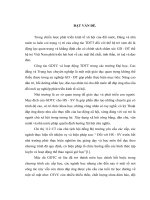
![[Luận văn]ảnh hưởng của tuổi ấu trùng và thế đàn tạo chúa theo phương pháp cấp tạo tới số lượng, chất lượng của ong chúa giống nội (apis cerana)](https://media.store123doc.com/images/document/13/gu/mg/medium_mgu1375970375.jpg)
